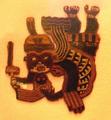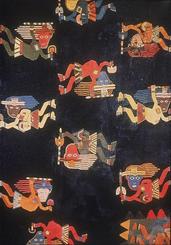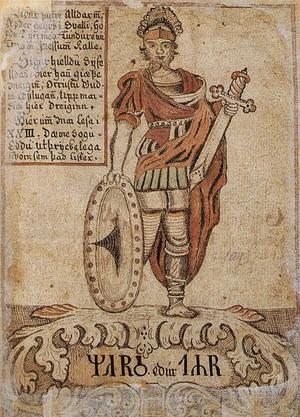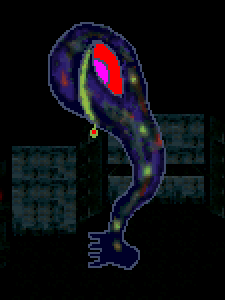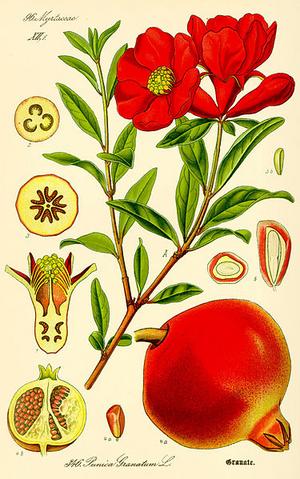>Mt.kiki No edit summary |
>Mt.kiki No edit summary |
||
| Line 1: | Line 1: | ||
[[File:Kyukyu.png|link=http://yumenikki.wikia.com/wiki/KyuuKyuu-kun|frame|left| | [[File:Kyukyu.png|link=http://yumenikki.wikia.com/wiki/KyuuKyuu-kun|frame|left|KyuuKyuu-kun(baluster)]] | ||
| Line 47: | Line 47: | ||
Moreover, the red devil, yellow devil, and the blue devil who are ousted on the eve of the beginning of spring are coming from here. | Moreover, the red devil, yellow devil, and the blue devil who are ousted on the eve of the beginning of spring are coming from here. | ||
---- | ---- | ||
Back ground image(the red devil, yellow devil, and the blue devil ) in [[Number_World#The_Stairway|The Stairway]]([http://en.wikipedia.org/wiki/Diyu Diyu]). | |||
[[Number_World#The_Stairway|The Stairway]]([http://en.wikipedia.org/wiki/Diyu Diyu]) → [http://yumenikki.wikia.com/wiki/Number_World(name)#The_Bed_Room.28Naraka_.28Buddhism.29.29 11 The Bed Room(Naraka (Buddhism))]? | [[Number_World#The_Stairway|The Stairway]]([http://en.wikipedia.org/wiki/Diyu Diyu]) → [http://yumenikki.wikia.com/wiki/Number_World(name)#The_Bed_Room.28Naraka_.28Buddhism.29.29 11 The Bed Room(Naraka (Buddhism))]? | ||
| Line 56: | Line 58: | ||
The Paracas textiles were found at a [http://en.wikipedia.org/wiki/Necropolis <u>necropolis</u>] in [http://en.wikipedia.org/wiki/Peru <u>Peru</u>] in the 1920s. | The Paracas textiles were found at a [http://en.wikipedia.org/wiki/Necropolis <u>necropolis</u>] in [http://en.wikipedia.org/wiki/Peru <u>Peru</u>] in the 1920s. | ||
[[File:555px-Paracas_textile_detail_British_Museum.jpg| | [[File:555px-Paracas_textile_detail_British_Museum.jpg|thumb|111px|Detail of one shaman showing knife and head]] | ||
Detail of one shaman showing knife and head | Detail of one shaman showing knife and head | ||
| Line 62: | Line 64: | ||
These textiles were made by South American people before the rise of the [http://en.wikipedia.org/wiki/Inca <u>Inca</u>] or the [http://en.wikipedia.org/wiki/Aztecs <u>Aztecs</u>]. | These textiles were made by South American people before the rise of the [http://en.wikipedia.org/wiki/Inca <u>Inca</u>] or the [http://en.wikipedia.org/wiki/Aztecs <u>Aztecs</u>]. | ||
[[File: | [[File:Paracas-textiles3.jpg|thumb|left|171px|Detail of one shaman showing knife and head]] | ||
[[File:Kyukyu.png|thumb|300px|The Stairway(Paracas Textiles)]] | |||
| Line 74: | Line 77: | ||
:: | |||
:: | |||
<p class="date-header">PARACAS III PARTE: Textiles ancestrales del Perú</p> | |||
<p class="date-header">http://imagenesytextosselectos.blogspot.jp/2012/02/paracas-iii-parte-textiles-ancestrales.html</p> | |||
---- | |||
Back ground image(Detail of one shaman showing knife and head) in [[Number_World#The_Stairway|The Stairway]]([http://en.wikipedia.org/wiki/Paracas_Textiles Paracas Textiles]). | |||
<p class="date-header">[[Number_World#The_Stairway|The Stairway]]([http://en.wikipedia.org/wiki/Paracas_Textiles Paracas Textiles]) → [http://yumenikki.wikia.com/wiki/Madotsuki%27s_Room(name)#Madotsuki.27s_Room.28Navajo_people.29 2 Madotsuki's Room(Navajo people)] and [[Madotsuki's Room]] Door.</p> | |||
| Line 109: | Line 111: | ||
[[File:IB_299_4to_Tyr.jpg|thumb|18世紀のアイスランドの写本『ÍB 299 4to』に描かれたテュール。]] | |||
==[[KyuuKyuu-kun]]([http://en.wikipedia.org/wiki/T%C3%BDr Týr])== | |||
[http://ja.wikipedia.org/wiki/%E9%9A%BB%E8%85%95#.E7.A5.9E.E8.A9.B1.E3.83.BB.E4.BC.9D.E6.89.BF <u>4 神話・伝承</u>] (One-Hand in the legend, myth) | |||
時代、地方によれば「身体障害者には不思議な力が宿る」とされたこともあり、[http://ja.wikipedia.org/wiki/%E9%9A%BB%E7%9C%BC <u>隻眼</u>]の神などがいるがあまり四肢の欠損した神などが登場することは少ない。しかし、腕の喪失はなんらかの力の喪失として語られることがある。腕とともに力を失った例として、[http://ja.wikipedia.org/wiki/%E5%8C%97%E6%AC%A7%E7%A5%9E%E8%A9%B1 <u>北欧神話</u>]の[http://ja.wikipedia.org/wiki/%E3%83%86%E3%83%A5%E3%83%BC%E3%83%AB <u>テュール</u>]がいる。伝承によれば、神々の間ではテュールの右手にかけて約束をする習慣があったというが、彼の右腕喪失とともに約束を守るという拘束力が弱まったというのである。 | |||
Rarely, such as God, which is deficient in the extremities too appeared sometimes age was According "to persons with disabilities mysterious power dwells" and in a rural location, but there is such as God of Sekigan. However, you may be told as a loss of some loss of arm strength. As an example of the power lost with the arm, there are Te~yuru of Norse mythology. According to the tradition, but said there was a habit of his right hand toward the promise of Te~yuru among the gods, a binding promise to protect the loss, along with his right arm is weakened by all means. | |||
----------------------------------------------- | |||
[[KyuuKyuu-kun]](some loss of arm strength?) and [[Number World]] Door is only Right arm. | |||
http://yumenikki.wikia.com/wiki/Number_World(name)#Number_World.28The_Evil_Eye_Door.29 | http://yumenikki.wikia.com/wiki/Number_World(name)#Number_World.28The_Evil_Eye_Door.29 | ||
==[[Mars-san]]([http://en.wikipedia.org/wiki/T%C3%BDr Týr])== | ==[[Mars-san]]([http://en.wikipedia.org/wiki/T%C3%BDr Týr])== | ||
| Line 142: | Line 146: | ||
Tiw was equated with [http://en.wikipedia.org/wiki/Mars_(mythology) <u>Mars</u>] in the [http://en.wikipedia.org/wiki/Interpretatio_germanica <u>interpretatio germanica</u>]. [http://en.wikipedia.org/wiki/Tuesday <u>Tuesday</u>] is in fact "Tīw's Day" (also in [http://en.wikipedia.org/wiki/Alemannic_German <u>Alemannic</u>] Zischtig from zîes tag), translating dies Martis. | Tiw was equated with [http://en.wikipedia.org/wiki/Mars_(mythology) <u>Mars</u>] in the [http://en.wikipedia.org/wiki/Interpretatio_germanica <u>interpretatio germanica</u>]. [http://en.wikipedia.org/wiki/Tuesday <u>Tuesday</u>] is in fact "Tīw's Day" (also in [http://en.wikipedia.org/wiki/Alemannic_German <u>Alemannic</u>] Zischtig from zîes tag), translating dies Martis. | ||
----------------------------------------------------- | |||
Mars-San(Tiw was equated with [http://en.wikipedia.org/wiki/Mars_(mythology) <u>Mars</u>] ?) and [[Number World]] Door is only One Leg. | |||
http://yumenikki.wikia.com/wiki/Mars(name)#Mars-San.28Nicole.27s_Leg.29 | http://yumenikki.wikia.com/wiki/Mars(name)#Mars-San.28Nicole.27s_Leg.29 | ||
| Line 152: | Line 156: | ||
A baluster — also called spindle or stair stick — is a moulded shaft, square or of [http://en.wikipedia.org/wiki/Lathe <u>lathe</u>]-turned form, one of various forms of [http://en.wikipedia.org/wiki/Spindle_(furniture) <u>spindle in woodwork</u>], made of stone or wood and sometimes of metal,<sup class="reference" id="cite_ref-1">[http://en.wikipedia.org/wiki/Baluster#cite_note-1 <u>[1</u>]]</sup> standing on a unifying footing, and supporting the [http://en.wikipedia.org/wiki/Coping_(architecture) <u>coping</u>] of a [http://en.wikipedia.org/wiki/Parapet <u>parapet</u>] or the [http://en.wikipedia.org/wiki/Handrail <u>handrail</u>] of a [http://en.wikipedia.org/wiki/Stairway <u>staircase</u>]. Multiplied in this way, they form a balustrade.<sup class="reference" id="cite_ref-2">[http://en.wikipedia.org/wiki/Baluster#cite_note-2 <u>[2</u>]]</sup> Individually, a baluster shaft may describe the turned form taken by a brass or silver candlestick, an upright furniture support, or the stem of a brass chandelier, etc. | A baluster — also called spindle or stair stick — is a moulded shaft, square or of [http://en.wikipedia.org/wiki/Lathe <u>lathe</u>]-turned form, one of various forms of [http://en.wikipedia.org/wiki/Spindle_(furniture) <u>spindle in woodwork</u>], made of stone or wood and sometimes of metal,<sup class="reference" id="cite_ref-1">[http://en.wikipedia.org/wiki/Baluster#cite_note-1 <u>[1</u>]]</sup> standing on a unifying footing, and supporting the [http://en.wikipedia.org/wiki/Coping_(architecture) <u>coping</u>] of a [http://en.wikipedia.org/wiki/Parapet <u>parapet</u>] or the [http://en.wikipedia.org/wiki/Handrail <u>handrail</u>] of a [http://en.wikipedia.org/wiki/Stairway <u>staircase</u>]. Multiplied in this way, they form a balustrade.<sup class="reference" id="cite_ref-2">[http://en.wikipedia.org/wiki/Baluster#cite_note-2 <u>[2</u>]]</sup> Individually, a baluster shaft may describe the turned form taken by a brass or silver candlestick, an upright furniture support, or the stem of a brass chandelier, etc. | ||
[[File:Baluster_(PSF).png|thumb| | [[File:Baluster_(PSF).png|thumb|49px|A baluster — also called spindle or stair stick]] | ||
手すり子またはバラスター(baluster)は、共通の基礎の上に立ち、[http://ja.wikipedia.org/wiki/%E9%9A%8E%E6%AE%B5 <u>階段</u>]などの[http://ja.wikipedia.org/wiki/%E6%89%8B%E6%91%BA <u>手すり</u>]や[http://ja.wikipedia.org/wiki/%E6%AC%84%E5%B9%B2 <u>欄干</u>]の笠木(手でつかむ横板状の部分)を支持する柱状の装飾的構造で、角柱、円柱、[http://ja.wikipedia.org/wiki/%E5%9B%9E%E8%BB%A2%E4%BD%93 <u>回転体</u>]などの形状があり、石や木材、時には金属でできている<sup class="reference" id="cite_ref-0">[http://ja.wikipedia.org/wiki/%E6%89%8B%E3%81%99%E3%82%8A%E5%AD%90#cite_note-0 <u>[1</u>]]</sup>。 | 手すり子またはバラスター(baluster)は、共通の基礎の上に立ち、[http://ja.wikipedia.org/wiki/%E9%9A%8E%E6%AE%B5 <u>階段</u>]などの[http://ja.wikipedia.org/wiki/%E6%89%8B%E6%91%BA <u>手すり</u>]や[http://ja.wikipedia.org/wiki/%E6%AC%84%E5%B9%B2 <u>欄干</u>]の笠木(手でつかむ横板状の部分)を支持する柱状の装飾的構造で、角柱、円柱、[http://ja.wikipedia.org/wiki/%E5%9B%9E%E8%BB%A2%E4%BD%93 <u>回転体</u>]などの形状があり、石や木材、時には金属でできている<sup class="reference" id="cite_ref-0">[http://ja.wikipedia.org/wiki/%E6%89%8B%E3%81%99%E3%82%8A%E5%AD%90#cite_note-0 <u>[1</u>]]</sup>。 | ||
| Line 158: | Line 162: | ||
It stands on the common foundation, and it is a pillar-shaped decorative structure which supports the cap piece (portion of the shape of a side held by hand) of handrails, such as stairs, or a railing, there is form, such as a square pillar, a pillar, and a rotating body, and a banister or a baluster (baluster) is a stone, wood, and [1] that is occasionally made of metal. | It stands on the common foundation, and it is a pillar-shaped decorative structure which supports the cap piece (portion of the shape of a side held by hand) of handrails, such as stairs, or a railing, there is form, such as a square pillar, a pillar, and a rotating body, and a banister or a baluster (baluster) is a stone, wood, and [1] that is occasionally made of metal. | ||
[[File:Kyukyu.png| | [[File:Kyukyu.png|thumb|left|300px|KyuuKyuu-kun(baluster)]] | ||
| Line 174: | Line 183: | ||
[[File:KyuuKyuu-kun.png|thumb|103px|KyuuKyuu-kun looks Pomegranate color.]] | |||
[[File:Illustration_Punica_granatum.jpg|thumb|left|Swelling form of the half-open flower of Punica granatum, in Italian balaustra (see etymology above)]] | [[File:Illustration_Punica_granatum.jpg|thumb|left|Swelling form of the half-open flower of Punica granatum, in Italian balaustra (see etymology above)]] | ||
| Line 179: | Line 189: | ||
"baluster" は[http://ja.wikipedia.org/wiki/%E3%82%AA%E3%83%83%E3%82%AF%E3%82%B9%E3%83%95%E3%82%A9%E3%83%BC%E3%83%89%E8%8B%B1%E8%AA%9E%E8%BE%9E%E5%85%B8 <u>OED</u>]によると「石榴の花」を意味する balaustra に由来し、半分開きかけた蕾に形状が似ているためにそのように名付けられたという<sup class="reference" id="cite_ref-1">[http://ja.wikipedia.org/wiki/%E6%89%8B%E3%81%99%E3%82%8A%E5%AD%90#cite_note-1 <u>[2</u>]]</sup>。手すり子が複数並んだ欄干を英語では "balustrade" と呼ぶ<sup class="reference" id="cite_ref-2">[http://ja.wikipedia.org/wiki/%E6%89%8B%E3%81%99%E3%82%8A%E5%AD%90#cite_note-2 <u>[3</u>]]</sup>。 | "baluster" は[http://ja.wikipedia.org/wiki/%E3%82%AA%E3%83%83%E3%82%AF%E3%82%B9%E3%83%95%E3%82%A9%E3%83%BC%E3%83%89%E8%8B%B1%E8%AA%9E%E8%BE%9E%E5%85%B8 <u>OED</u>]によると「石榴の花」を意味する balaustra に由来し、半分開きかけた蕾に形状が似ているためにそのように名付けられたという<sup class="reference" id="cite_ref-1">[http://ja.wikipedia.org/wiki/%E6%89%8B%E3%81%99%E3%82%8A%E5%AD%90#cite_note-1 <u>[2</u>]]</sup>。手すり子が複数並んだ欄干を英語では "balustrade" と呼ぶ<sup class="reference" id="cite_ref-2">[http://ja.wikipedia.org/wiki/%E6%89%8B%E3%81%99%E3%82%8A%E5%AD%90#cite_note-2 <u>[3</u>]]</sup>。 | ||
It is said that "baluster" was named such since according to OED it originated in balaustra which means "the flower of a pomegranate" and form resembled a half difference or a beam bud [2].<br />A banister calls "balustrade" the railing located in a line in English [3]. [ two or more ]<br />It is "balustrade" using a banister all to have called it the railing henceforth. | |||
[[Category:Name]] | [[Category:Name]] | ||
Revision as of 11:30, 29 July 2013
The Stairway(Diyu)
1 概説 1.1 地獄の色 (1 Outline 1.1 An infernal color)
東アジアの仏教では、地獄の色は道教的に、あるいはその影響を受けた陰陽道的に「黒」で表す。
At the Buddhism of East Asia, an infernal color is expressed with "black" to a Taoism target or the Yin Yang philosophy target which was subject to the influence.
餓鬼は赤、畜生は黄、修羅は青、この三色を混ぜると地獄の黒になると言われる。
A red brat, a yellow beast, the blue favorable realms of bellicose spirits.
If these 3 colors are mixed, it will be said that it becomes infernal black.
また、節分で追われる赤鬼、黄鬼、青鬼はここから来ている。
Moreover, the red devil, yellow devil, and the blue devil who are ousted on the eve of the beginning of spring are coming from here.
Back ground image(the red devil, yellow devil, and the blue devil ) in The Stairway(Diyu).
The Stairway(Diyu) → 11 The Bed Room(Naraka (Buddhism))?
Diyu (Sanskrit: नरक "Naraka") is the realm of the dead or "hell" in Chinese mythology.
The Stairway(Paracas Textiles)
The Paracas textiles were found at a necropolis in Peru in the 1920s.
Detail of one shaman showing knife and head
1 Description These textiles were made by South American people before the rise of the Inca or the Aztecs.
PARACAS III PARTE: Textiles ancestrales del Perú
http://imagenesytextosselectos.blogspot.jp/2012/02/paracas-iii-parte-textiles-ancestrales.html
Back ground image(Detail of one shaman showing knife and head) in The Stairway(Paracas Textiles).
The Stairway(Paracas Textiles) → 2 Madotsuki's Room(Navajo people) and Madotsuki's Room Door.
KyuuKyuu-kun(Týr)
4 神話・伝承 (One-Hand in the legend, myth)
時代、地方によれば「身体障害者には不思議な力が宿る」とされたこともあり、隻眼の神などがいるがあまり四肢の欠損した神などが登場することは少ない。しかし、腕の喪失はなんらかの力の喪失として語られることがある。腕とともに力を失った例として、北欧神話のテュールがいる。伝承によれば、神々の間ではテュールの右手にかけて約束をする習慣があったというが、彼の右腕喪失とともに約束を守るという拘束力が弱まったというのである。
Rarely, such as God, which is deficient in the extremities too appeared sometimes age was According "to persons with disabilities mysterious power dwells" and in a rural location, but there is such as God of Sekigan. However, you may be told as a loss of some loss of arm strength. As an example of the power lost with the arm, there are Te~yuru of Norse mythology. According to the tradition, but said there was a habit of his right hand toward the promise of Te~yuru among the gods, a binding promise to protect the loss, along with his right arm is weakened by all means.
KyuuKyuu-kun(some loss of arm strength?) and Number World Door is only Right arm.
http://yumenikki.wikia.com/wiki/Number_World(name)#Number_World.28The_Evil_Eye_Door.29
Mars-san(Týr)
テュールが最高神であった時代のゲルマン人諸族の王を意味する語は、ティワズの祭司を意味するティウダンス (thiudans) であった。 絵画などでは隻腕の戦士の姿で表され、これはフェンリルに片手を食いちぎられたことを示す。 またルーン文字のティールは軍神テュールの象徴で勝利を意味する。戦いの際にこのルーンを剣に刻み勝利を祈ったとされる。
軍神という点でローマ神話の軍神マールスと同一視され、ゲルマン語で火曜日を意味する語 (Tuesday など) の語源となった。
Týr (pron.: /ˈtɪər/;[1] Old Norse: Týr [tyːr]) is the god of Law, the althing, Justice, The Sky, and heroic glory in Norse mythology, portrayed as a one-handed man. Corresponding names in other Germanic languages are Gothic Teiws, Old English Tīw and Old High German Ziu and Cyo, all from Proto-Germanic *Tîwaz (*Tē₂waz). The Latinised name is Tius or Tio.[2]
Tiw was equated with Mars in the interpretatio germanica. Tuesday is in fact "Tīw's Day" (also in Alemannic Zischtig from zîes tag), translating dies Martis.
Mars-San(Tiw was equated with Mars ?) and Number World Door is only One Leg.
http://yumenikki.wikia.com/wiki/Mars(name)#Mars-San.28Nicole.27s_Leg.29
KyuuKyuu-kun(Baluster)
A baluster — also called spindle or stair stick — is a moulded shaft, square or of lathe-turned form, one of various forms of spindle in woodwork, made of stone or wood and sometimes of metal,[1] standing on a unifying footing, and supporting the coping of a parapet or the handrail of a staircase. Multiplied in this way, they form a balustrade.[2] Individually, a baluster shaft may describe the turned form taken by a brass or silver candlestick, an upright furniture support, or the stem of a brass chandelier, etc.
手すり子またはバラスター(baluster)は、共通の基礎の上に立ち、階段などの手すりや欄干の笠木(手でつかむ横板状の部分)を支持する柱状の装飾的構造で、角柱、円柱、回転体などの形状があり、石や木材、時には金属でできている[1]。
It stands on the common foundation, and it is a pillar-shaped decorative structure which supports the cap piece (portion of the shape of a side held by hand) of handrails, such as stairs, or a railing, there is form, such as a square pillar, a pillar, and a rotating body, and a banister or a baluster (baluster) is a stone, wood, and [1] that is occasionally made of metal.
"baluster" はOEDによると「石榴の花」を意味する balaustra に由来し、半分開きかけた蕾に形状が似ているためにそのように名付けられたという[2]。手すり子が複数並んだ欄干を英語では "balustrade" と呼ぶ[3]。
It is said that "baluster" was named such since according to OED it originated in balaustra which means "the flower of a pomegranate" and form resembled a half difference or a beam bud [2].
A banister calls "balustrade" the railing located in a line in English [3]. [ two or more ]
It is "balustrade" using a banister all to have called it the railing henceforth.


